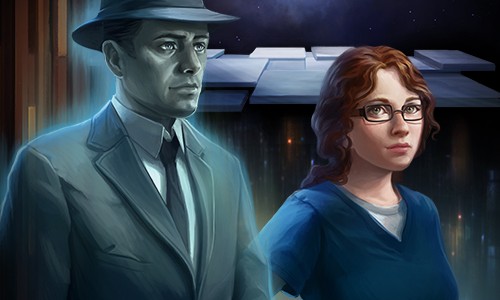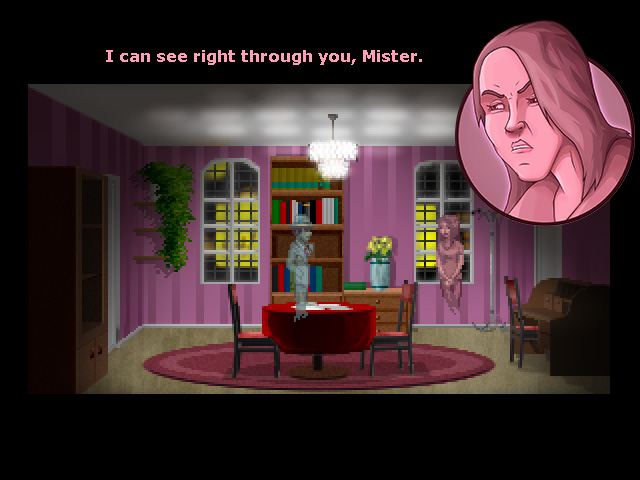Let’s not beat around the bush; point-and-click adventure games are largely a thing of the past. Games focusing on narrative are still present, but most have evolved mechanically past simply pointing at objects with a computer mouse. However, Wadjet Games apparently has not received the memo and produced a series of point-and-click adventure games anyway. The Blackwell Deception is the fourth game in the Blackwell series. After playing through the game, I’d say it’s a good thing their fax machine is broken.
The Blackwell Deception features two main characters: Rosangela Blackwell, a writer living in New York City who is able to see and communicate with ghosts, and Joey Mallone, a ghost himself from the 1970s. Both characters work together to send spirits who have not yet accepted their death to the afterlife. The dynamic between Rosangela and Joey works well; Rosangela is a bit insecure and sarcastic while Joey ramps up the sarcasm to a fever pitch with cynicism of his own. While both do share this common goal of sending in-limbo ghosts along their way, the dialogue between them features subtle conflicts and hilarious dry humor. Even with this, their relationship is convincing as they both portray enough determination to solve the problems given to them.

This story centers on the world of underground psychics and the harmful influence it’s having on certain residents of NYC. After finding a common link between all of the ghosts’ deaths, it’s up to Rosangela and Joey to uncover the secrets of the street psychics and find those responsible for the numerous murders of innocent people. During this journey, fans of the series will be pleased to find that the character of Joey develops further. The game delves deeper into his history to answer and raise questions about Joey’s past life and death. Unfortunately, the same treatment isn’t given to Rosangela as she remains largely unchanged as a character throughout the ordeal. In some instances it seems that gamers will learn more about her (like when she meets her teacher from ten years ago) but it doesn’t pan out as well as Joey’s story arc.
The Blackwell Deception features many nice touches throughout that cements the experience. For starters, the voice-acting is top notch with both Rosangela and Joey. The lines are delivered effectively with the appropriate emotional tones while the other support characters are voiced in the same successful manner. It is always amusing to see how the in-limbo ghosts try to justify why things around them are so different rather than realize they are dead. Also, since Joey is from the 1970s he sees objects during present day NYC differently than Rosangela. When playing as Joey, he identifies a strange black case and a new cassette player whereas Rosangela clearly knows it is a laptop case and an old tape player. Furthermore, after going through the game with Rosangela and other ghosts being the only ones to be able to see Joey, it is neat to see the baby in the room follow Joey around because, apparently, infants can see ghosts before they grow up. These little additions to the game may seem trivial but they ultimately further immerse players into the world of The Blackwell Deception.
The game mechanics themselves are straightforward: click your mouse over objects for clues and interactions. If gamers are looking for anything more from a purely mechanical perspective, they should look elsewhere. However, after playing the game in its entirety, anything more would feel tacked on and perhaps the game would’ve lost its charm. Blackwell Deception is more about the narrative, dialogue, and puzzle solving.
The contrasting abilities of Rosangela and Joey work well. Rosangela is blocked by locked doors while Joey can pass right through them, but Joey has no physical abilities and can only observe and blow on objects while Rosangela can physically interact with them. This disparity works well when solving puzzles and sticky situations as the gamer is able to switch between the two characters at any time. The puzzles themselves are usually dialogue-related with the reward being new information to help move along the story. It would have been interesting for the game to give more complexity to the puzzles and see more unorthodox solutions as they were usually pretty straightforward. There were very few instances where a lot of moving parts were needed to solve a dilemma, and with the contrasting abilities of both characters it was a bit of a let down. But either way, the game provides some challenge and the puzzles to help move the story along.
Also, a notable addition in this Blackwell game is Rosangela’s new smart phone. No longer will gamers have to travel to her apartment to look up information on her computer. Rather, they can pull out their phone and use the “Oogle” search function. It was always fun to realize, “Hey, I can just look this up on my phone!” in the game.

The graphics in this game are purposefully retro. It tries to fit the style of the old point-and-clicks of fifteen years ago. The game is mostly 32-bit except for the effectively drawn character faces in the dialogue box. After seeing these nicely-rendered faces, it would have been nice to see the whole game designed more like this, but it does hit the nostalgia string effectively. The music is done well, with tunes appropriately placed such as jazz sounds in your apartment or haunting melodies in a street psychic’s apartment. It is especially effective when the music would stop altogether when new shocking revelations are uncovered.
If gamers are looking for a quality point-and-click adventure with a unique blend of characters and a distinct narrative to drive the action, they should seriously consider picking this up. It doesn’t offer the hardest puzzles or the shiniest graphics, but its strong points, the story and dialogue, are strong indeed. And since this is supposed to be the main selling point of a point-and-click adventure game, The Blackwell Deception proves to be a fine piece of interactive media.



















